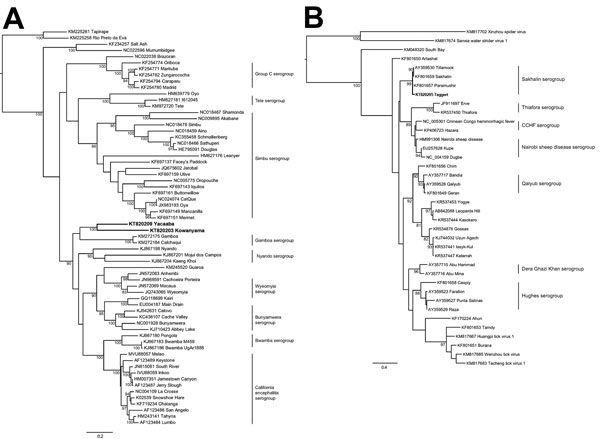Genetic Characterization of Archived Bunyaviruses and their Potential for Emergence in Australia
Bixing Huang, Cadhla Firth, Daniel Watterson, Richard Allcock, Agathe M.G. Colmant, Jody Hobson-Peters, Peter D. Kirkland, Glen Hewitson, Jamie McMahon, Sonja Hall-Mendelin, Andrew F. van den Hurk, and David Warrilow

Author affiliations: Author affiliations: Queensland Health Forensic and Scientific Services, Brisbane, Queensland, Australia (B. Huang, G. Hewitson, J. McMahon, S. Hall-Mendelin, A.F. van den Hurk, D. Warrilow); Commonwealth Scientific and Industrial Research Organisation, Geelong, Victoria, Australia (C. Firth); The University of Queensland, St. Lucia, Queensland, Australia (D. Watterson, A.M.G. Colmant, J. Hobson-Peters); University of Western Australia, Nedlands, Western Australia, Australia (R. Allcock); QEII Medical Centre, Nedlands (R. Allcock); Elizabeth Macarthur Agriculture Institute, Menangle, New South Wales, Australia (P. Kirkland)
Main Article
Figure 4

Figure 4. Phylogenetic trees including bunyaviruses from Australia. A) Relationship of Kowanyama and Yacaaba viruses (both in boldface) to other orthobunyaviruses constructed by using the predicted open reading frame sequence of the glycoprotein with a maximum-likelihood model. B) Relationship of Taggert virus (boldface) to other nairoviruses demonstrated by using the predicted open reading frame of a short fragment of the large segment (<450 nt) and a maximum-likelihood model. Virus serologic and genetic groups are shown to the right in each panel. Bootstrap values are shown as a percentage of 1,000 replicates. GenBank accession numbers are shown. CCHF, Crimean-Congo hemorrhagic fever. Scale bars indicate amino acid substitutions per site.
Main Article
Page created: April 13, 2016
Page updated: April 13, 2016
Page reviewed: April 13, 2016
The conclusions, findings, and opinions expressed by authors contributing to this journal do not necessarily reflect the official position of the U.S. Department of Health and Human Services, the Public Health Service, the Centers for Disease Control and Prevention, or the authors' affiliated institutions. Use of trade names is for identification only and does not imply endorsement by any of the groups named above.
